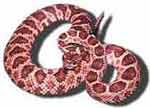|
The family Viperidae contains venomous species ranging from the readily recognizable rattlesnakes to the vipers of the old world. The envenomation mechanism of members of this family are at the highest form of development (Goin and Goin 1971). The fangs are hollow and connected to venom glands to allow the injection of venom when biting. When the mouth is closed, the long fangs are folded up towards the roof of the mouth. When Vipers strike, their fangs swing foward to puncture the target and allow envenomation. The family contains 20-27 genera that are distributed across North, Central and South America, eastern Asia, Africa, and Eurasia (Pough et al. 1998). The Idaho representative of this family is the Western Rattlesnake (Crotalus viridis). |

|